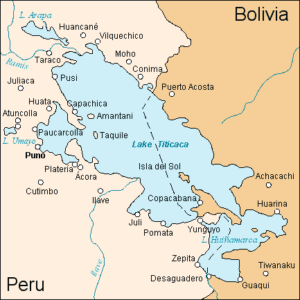Lake Titicaca
Lake Titicaca is the largest lake in South America and at over three kilometres is arguably the highest navigable lake in the world**, shared by Peru and Bolivia. In spite of claims to the  contrary it is a fresh water lake, but is slowly reducing in size due reduced inflow from the retreating Andean glaciers. Lake Poopó to the south has now dried out completely(a).
contrary it is a fresh water lake, but is slowly reducing in size due reduced inflow from the retreating Andean glaciers. Lake Poopó to the south has now dried out completely(a).
***Karakul in Tajikistan exists at 4,000 metres and “is so salty, it’s almost impossible to navigate a boat on it without capsizing due to the vessel riding so far out of the water.”(e)*
To the south of the lake are remarkable archaeological remains of Tiwanaku and the equally exciting Puma Punku. Both sites have produced some extreme theories regarding the builders of these monuments, their technology level and the date of their construction. Arthur Posnansky, followed by Kurt Bilau have proposed a date of circa 9500 BC as the date of fall of Tiwanaku. There are also reports of pre-Incan structures submerged in Titicaca(d) .
South of Lake Titicaca, near Lake Poopó is Pampa Aullagus, a site identified by Jim Allen as the location of Plato’s Atlantis. While there is little doubt that advanced cultures existed around Titicaca, linking the region to Plato’s story is stretching credibility to its limits. I have already argued in respect of Jim Allen’s Andean theory, that the idea of an invasion of the eastern Mediterranean by an army from the west side of South America is untenable. That they would try it in reed boats like those of Titicaca is equally daft. Then, that this mighty army from ten regions of South America were defeated by the small city-state of Athens is just as laughable.
Equally questionable is the idea that there was a Sumerian presence around Titicaca, in relation to which Clyde Winters quotes(b) James Bailey as well as Ruth and A. Hyatt Verrill in supporting the idea that Lake Manu in Sumerian tradition was in fact Titicaca. The controversial(c) Fuente Magna bowl is also offered as evidence of this idea.
(c) https://www.jasoncolavito.com/blog/the-fuente-magna-bowl-still-fake
*(e) https://www.bbc.com/travel/story/20190207-asias-dead-lake-where-boats-cant-float*
